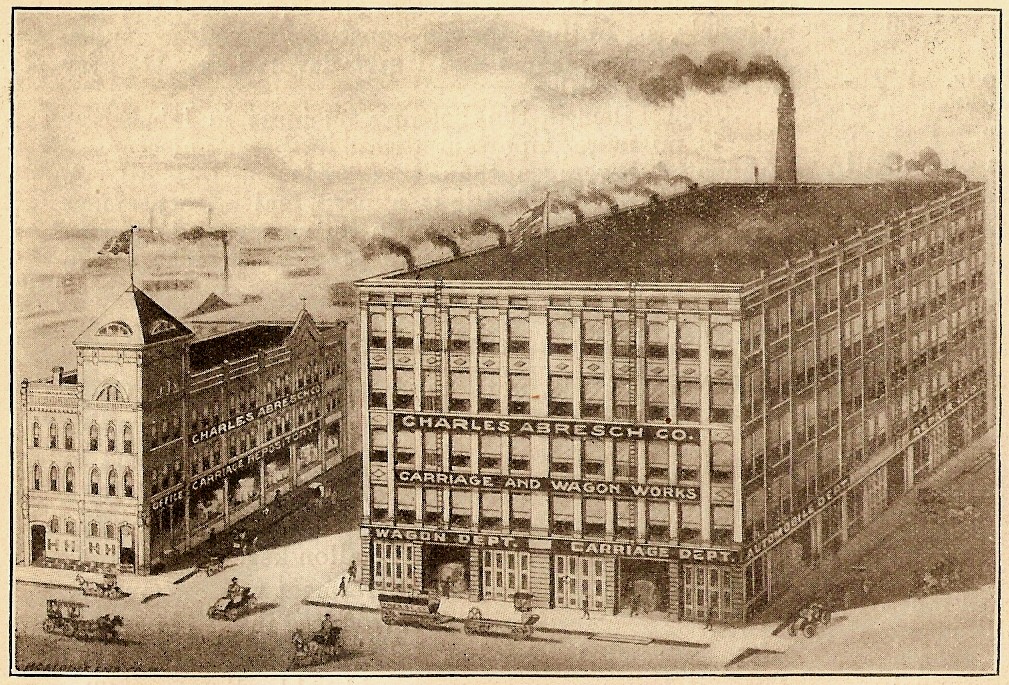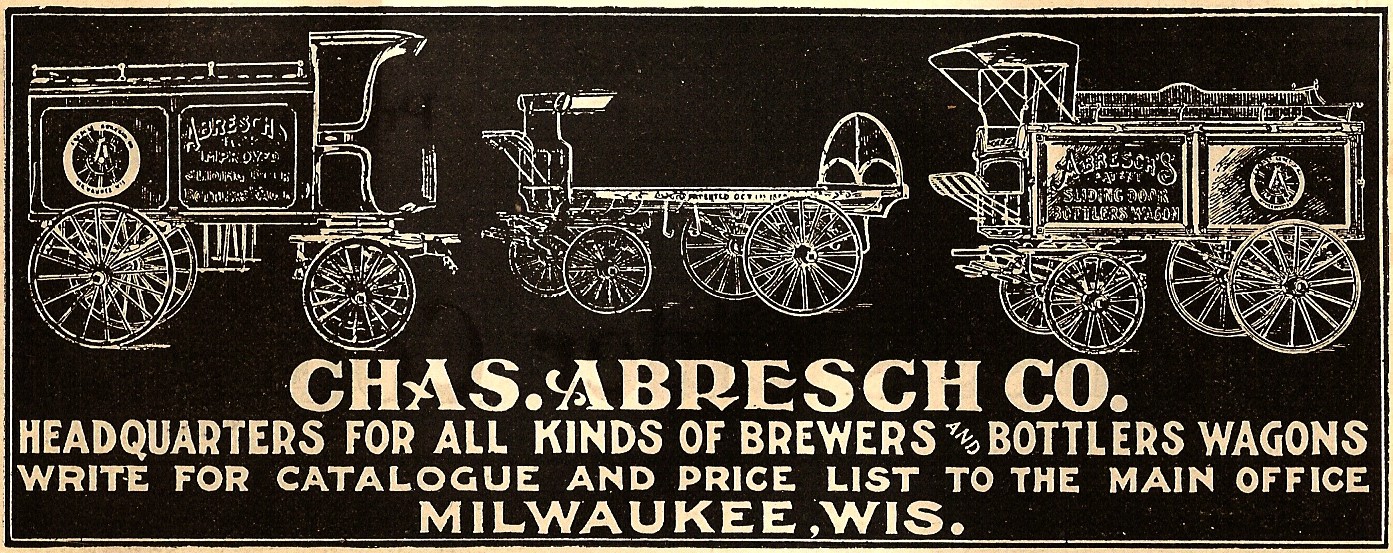Delivery
Bottlers’ wagons were
usually attractively painted and often highly ornamental.
They typically held 40 to 65 cases of sodas on several decks.
Most bottling plants employed a blacksmith or teamster to care
for their horses and delivery wagons.
During the summer months, the cases were often covered with straw
mats to shade the bottled goods from the hot sun.
One of the larger manufacturers of bottlers' wagons was profiled in the October 5, 1903 National Bottlers Gazette:
Where to Buy Your Trade Supplies
We take pleasure in exhibiting a cut of perhaps the finest wagon factory building in the country, that of the Charles Abresch Co., of Milwaukee, Wis. The building is of brick, four stories high with stone foundation, 100 feet long and 150 feet deep. It is lighted throughout with electricity and is heated by the hot air fan system of heating and ventilating. The stock room occupies the whole of the basement, which, with the cement floor and well-arranged racks, looks like a good sized wagon hardware store. The first floor is taken up with the engine, the electric tire welding and hydraulic tire setting machines, gas tire heater, shearing and punching machines, and 15 blacksmith fires, worked to their utmost capacity.

The wood shop occupies the whole of the second floor the south half containing the latest improved wood working machinery and the north half 24 wood workers benches. The Abresch wagons, known throughout the country as 'built to last,' owe this reputation to this same body shop and the company is receiving orders daily for automobile bodies, even in as large numbers as 500 lots.
The entire third floor is where that most important part 'painting' is done. The Abresch Company probably takes more pains in the striping, lettering and finishing of their wagons than does any maker, using but the highest priced colors and employing only skilled labor.
Mr. Chas. Abresch, president of the company, established this business in 1871, and with the able assistance of Mr. Louis Schneller, superintendent and manager, has seen the business grow to its well-earned proportions.

These
WAGON VERSUS RAIL.
By Blumenthal Bros.,
The Bottler who ships by rail where he can
possibly ship by wagon, is, in our opinion, making a great mistake.
By rail the breakage is enormous.
Cases are lost and seldom found.
Cases are broken into.
Bottles are stolen.
The railroad company sidetracks your shipments, and nothing
short of a dynamite bomb will make them do different.
Not that the railroad company does it intentionally – try to
run a great railroad and you’ll find out why.
Then your goods are lost or broken; you fight the claim until
your hair turns gray – all for rail shipments.
There are other reasons – you know them
On the other side, the wagon is a traveling
advertisement. (You can
cover it with signs.)
With a wagon you can gather trade from places the rail don’t reach.
You can save freight for your trade.
You can keep track of your empties.
You can collect your bills better.
You run no risk of breakage.
Your bottles are not stolen.
You don’t have to keep such a big supply of bottles and
cases, and a wagon makes things look prosperous.
HORSE DON’TS.
By Preston Clark,
Don’t put sound money into an unsound horse.
You can’t get it out again; not honestly.
Insist upon a few days’ trial.
Horses’ faults and weak spots can be known in no other way.
A horse may go sound, look good and show well, only to go
down on your hands when put to work.
Keep your good money until you know whether you are buying a
gold brick or not.
Don’t buy a horse with rubber shoes, with a
suspicious leg or with one foot smaller than the other, no matter
what any man says.
Don’t take a horse to a stable and get robbed.
If one is to be sold, advertise and sell it yourself.
You don’t have to hire an orator.
The less said in praise of a horse the quicker it will sell.
Don’t have a freezing stable.
Would you be in good condition for work if you have to lie
cold and shivering all night?...
Don’t let a wagon go out without water-proof
covers for the horses.
They save the horses and they save the harness…Many a good animal
dates its downfall from a sleet storm or a cold summer drenching
when it was warm with its work.
Don’t allow drivers to put horses away carelessly.
Have them wash the mud from the legs and belly, dry off and
blanket…
Don’t feed poor hay.
It is largely a waste of money to buy over-ripe, musty,
discolored or bleached out hay, which does not nourish the horse…
Don’t feed whole grain.
Much of it is swallowed whole and does no good.
Try some litter on the rose garden.
Grain will grow up from it as thick as hair on the horse.
MULES.
By W. S. Huber,
I am surprised that so many bottlers cannot get
out of the habit of using horses for motive power in place of mules.
As mules do more work with considerable less feed and
attendance. You can
work a mule two to three hours a day longer than a horse.
Mules are always hearty and good eaters, while a horse that
is overworked stands in a stable and hangs his head down, too tired
to eat. I have had the
experience, and would not change back to horses under any
consideration. I say
mules every time and all the time; the best and the cheapest.
GOOD HORSE TIP.
By K. M. Schade, S. & S. Bottling
Works,
To cure a balky horse: Take him from the carriage,
whirl him rapidly around until he is giddy.
It requires two men to accomplish this; one at the horse’s
head, one at the horse’s tail.
Don’t let him step out.
Hold him to the smallest possible circle.
One dose will often cure him.
Two doses are final with the worst horse that ever refused to
stir.
HORSE CURE.
By W. H. Cawley Co.,
We find that it pays to have a man to have entire
charge of our harness, horses and wagons.
We pay a good price for a good man.
The horses look better, wear better and are better.
The harness lasts longer and always looks bright.
The wagons are always ready for use and in good condition.
It was our custom to have drivers attend to that work, but
the change pays big.
USING DULL MOMENTS.
By T. O. Kelly, Batson Bottling
Works, Batson, Harding Co.,
Once a month hook up a span of your best horses,
decorate your wagon and load it full of say two of your best drinks.
Have your driver dress up and look pleasant, and then you
take a bath and put on your glad clothes and start out among the
best people of your town.
Present the lady of the house with two bottles of your best
drinks, wishing her an increasing thirst for something good, and
tell her that you take up the empty bottles next morning and get her
order. You will find
this will add to your bank account if you keep it up.
BURSTING BOTTLES.
By Messrs. Boyd & Fulford, Bel Air,
We have had a great many complaints of bottles
bursting this summer.
Our driver took precautions to find out the cause if possible.
It was found that if the bottled goods were put in the ice
box and directly on the ice after being exposed to the sun’s heat
(along perhaps a considerable distance) they were more liable to
burst than if put in the chamber apart from the ice.
 HutchBook.com
HutchBook.com